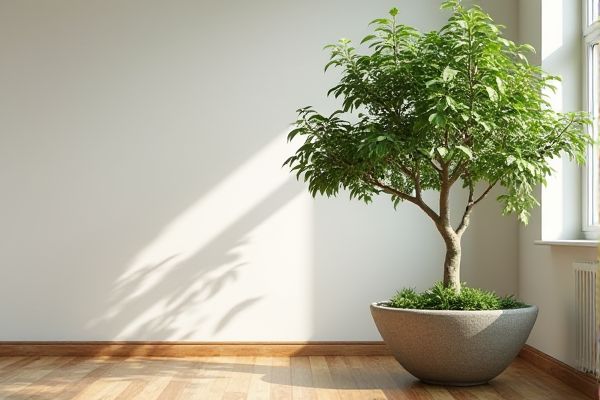
Choosing between a potted tree and an in-ground tree depends on your space, climate, and maintenance preferences, with potted trees offering mobility and control, while in-ground trees typically provide better growth potential and root development. Explore the key differences, benefits, and care tips to determine which option suits your gardening needs best.
Table of Comparison
| Feature | Potted Tree | In-Ground Tree |
|---|---|---|
| Mobility | Easy to move and reposition | Stationary, fixed location |
| Root Space | Limited root growth in container | Unlimited root expansion in soil |
| Growth Rate | Slower due to restricted roots | Faster and larger growth potential |
| Water Requirements | Frequent watering needed | Less frequent, natural soil moisture |
| Soil Quality Control | Easier to control soil nutrients | Depends on native soil quality |
| Longevity | Generally shorter lifespan | Longer lifespan with proper care |
| Space Requirements | Compact, suitable for small spaces | Requires adequate garden or yard space |
| Climate Adaptability | Can be moved indoors during cold seasons | Exposed to outdoor climate year-round |
| Cost | Generally higher initial cost and maintenance | Lower planting cost, maintenance varies |
Introduction to Potted vs. In-Ground Trees
Potted trees offer flexibility and mobility, allowing you to easily relocate them according to space or sunlight needs, making them ideal for patios or small gardens. In-ground trees establish stronger root systems, promoting faster growth and greater resilience to environmental stress over time. Understanding the differences between potted and in-ground trees helps you choose the best option for your landscape and gardening goals.
Space Requirements and Flexibility
Potted trees require significantly less space and can be moved easily, making them ideal for small patios, balconies, or urban gardens where flexibility is crucial. In-ground trees demand permanent space, often needing larger soil volume for root expansion and stability, limiting their placement and replanting options. The mobility of potted trees allows for seasonal adjustments and protection from harsh weather, providing versatile landscaping solutions.
Growth Rate and Size Comparison
Potted trees generally exhibit slower growth rates and remain smaller in size compared to in-ground trees due to restricted root space and limited nutrient availability. In-ground trees benefit from unrestricted root expansion, facilitating faster growth and larger mature sizes. Root confinement in containers also leads to increased root circling, which can inhibit development and reduce overall tree vigor.
Soil Control and Nutrient Management
Potted trees offer precise soil control, allowing you to tailor nutrient levels and pH for optimal growth, which is harder to achieve with in-ground trees due to variable native soil conditions. In-ground trees rely on natural soil composition and benefit from broader nutrient sources but face challenges with soil compaction and drainage issues. Managing nutrient availability is more straightforward in containers, enabling targeted fertilization to support healthy root development.
Watering Needs and Moisture Regulation
Potted trees require more frequent watering due to limited soil volume and faster moisture evaporation, often needing daily or bi-daily attention during warm periods. In-ground trees benefit from deeper rooting zones that provide natural moisture regulation and better access to groundwater, reducing the frequency of watering. Using mulch around potted trees can help retain moisture, while in-ground trees rely on natural soil textures and organic matter to maintain hydration balance.
Climate Adaptability and Protection
Potted trees offer greater climate adaptability by allowing relocation indoors or to sheltered areas during extreme weather conditions, protecting roots from frost or excessive heat. In-ground trees rely on natural soil insulation but are more vulnerable to climate fluctuations such as drought or cold snaps due to their fixed position. Protective measures for in-ground trees often include mulching and windbreaks, while potted trees benefit from controlled watering and temperature management.
Pest and Disease Management Differences
Potted trees often face higher risks of pest infestations and diseases due to limited soil volume and restricted root growth, which can stress the plant and reduce its natural defenses compared to in-ground trees. In-ground trees benefit from a diverse soil ecosystem that supports beneficial microorganisms and improved drainage, lowering susceptibility to root diseases and pests. Effective pest and disease management for potted trees requires vigilant monitoring, sterile potting media, and regular soil replacement, while in-ground trees generally need routine inspection and targeted treatments for local pest populations.
Maintenance and Pruning Requirements
Potted trees demand more frequent watering and nutrient replenishment compared to in-ground trees due to limited soil volume. Pruning for potted trees often involves controlling size to fit the container, while in-ground trees require strategic pruning for health and structural integrity. Your choice impacts maintenance intensity, with potted trees needing more hands-on care and monitoring for root health.
Longevity and Lifespan
Potted trees typically have a shorter lifespan than in-ground trees due to limited root space and nutrient availability, which can restrict growth and increase susceptibility to stress. In-ground trees benefit from natural soil conditions, deeper root systems, and greater access to water and nutrients, leading to enhanced longevity and resilience. Your choice between potted and in-ground trees should consider the desired lifespan and maintenance commitment.
Cost Considerations and Investment
Potted trees typically involve lower initial costs and offer flexibility for relocation but may require more frequent watering and maintenance, increasing long-term expenses. In-ground trees often demand a higher upfront investment for planting and soil preparation but provide greater stability and potentially lower maintenance costs over time. Evaluating your budget and long-term landscaping goals ensures that your investment aligns with both cost efficiency and desired outcomes.
 homyna.com
homyna.com